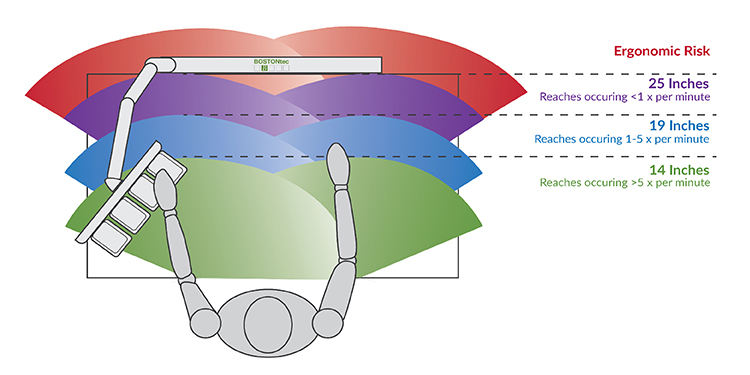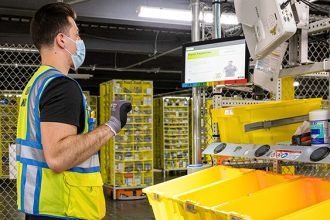
If your operation’s throughput isn’t as high as you think it should be, or your workers aren’t as productive as you expect, perhaps some ergonomic adjustments are in order. That’s because the science of ergonomics aims not only to remove the risk factors associated with musculoskeletal injuries, but it also seeks to improve workers’ efficiency as they complete assigned tasks.
Consider the workstation, for example. Whether a worker is packing shipping cartons in an e-commerce fulfillment operation or assembling small workpieces, take a look at the work environment. Determine what task (or tasks) are to be performed at that station and what tools are needed to complete that work. Evaluate the number of discrete process steps that must be taken, and the motions performed to complete those steps. Then, consider whether the workstation is organized in the most efficient manner.
To maximize ergonomics and worker productivity, a workstation should be laid out according to a few basic principles. The first is to define reach zones — or the range of distance a worker must extend his or her hand and arm — for necessary tools or supplies based on frequency of use in order to minimize the time spent searching for or accessing them. Zones are typically established according to the following guidelines:
- High priority items required to complete highly repetitive tasks or reached for more than 5 times per minute should be placed no farther than 14 inches away from the worker’s body.
- Items needed less often, or reached for between 1-5 times per minute, should be placed in a secondary zone, up to 19 inches away from the worker’s body.
- Items used least, or less than once per minute, can be placed up to 25 inches away from the worker’s body.
- Any other items that are rarely used should be placed in a storage zone.
The tools or supplies themselves can be mounted on extendible trays or arms for flexible, adjustable access within specific reach zones. They can also be sorted into different colored bins or marked with different colored adhesive labels for high visibility and to separate items that appear similar but are not (different sized bolts and nuts, for example). This makes finding the right part or supply faster and easier. To further bolster efficiency, the items required for the task should be sub-organized in order of use, left to right, top to bottom (the same way English speakers read a page of a book).
Additionally, if multiple operators are using the same workstation, utilize powered adjustability functions to raise and lower the surface to each user’s height. The adjustability ensures that workers are standing or seated in the most comfortable position to perform their assigned task, minimizing stretching, reaching, bending or other strains. Manually adjustable surfaces (for example by crank) are less likely to be used, as workers will rarely spend the few minutes required to raise or lower the station by hand. If monitors or other screens are used, they too should be mounted on adjustable height arms so workers can position them for easiest viewing.
Having the right amount, type, and intensity of lighting — both ambient and task — is crucial to efficiency. If a worker cannot easily see the task in front of them, they are more likely to make mistakes or take more time to complete the work. Consider adding powered tools, such as screwdrivers or automated dispensers, to further save time and reduce strain in completing tasks.
Additionally, only items needed to perform the task should be stored at the workstation and the work surface should remain open and free of clutter. Some items, such as printers or other tools, should not be placed on the work surface. There are ergonomic solutions available that place printers and other devices on pull-out shelves, clearing space on the work surface. In addition, accessories like bin rails and label troughs can help keep items that are needed for the task close to the worker. A lot of time can be wasted if a worker has to search for a missing tool or supply item, like a tape gun.
Finally, when it comes to sizing the workstation, many operations erroneously believe that having a larger work surface is better than a small one. However, additional space can increase the distance a worker has to stretch to reach items; it may also encourage unnecessary items to accumulate. Instead, choose a well-designed station that is as compact as it can be for the task. That makes it easier for workers to keep their workstations clean, organized and free of clutter.
Need more insight into how industrial ergonomic solutions can help both your workforce and your bottom line? Watch this video produced by the members of MHI’s Ergonomic Assist Systems & Equipment (EASE) Industry Group.



